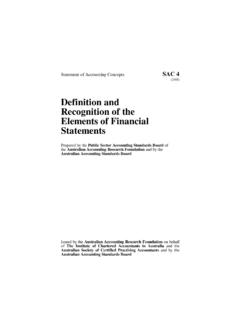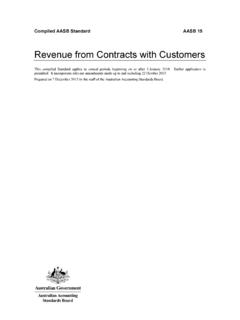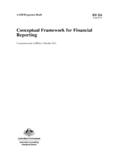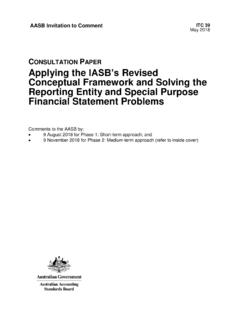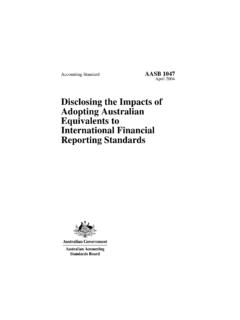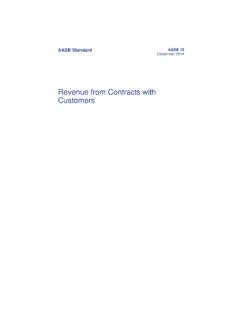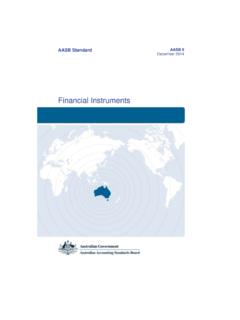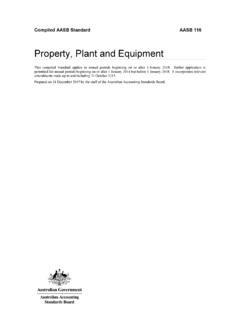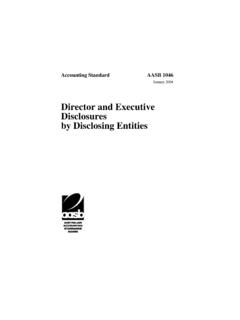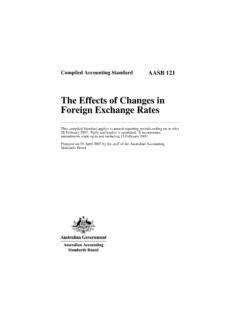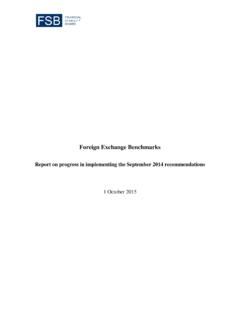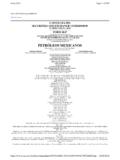Transcription of The Effects of Changes in Foreign Exchange Rates
1 AASB Standard AASB 121. August 2015. The Effects of Changes in Foreign Exchange Rates Federal Register of Legislative Instruments F2015L01580. Obtaining a copy of this Accounting Standard This Standard is available on the AASB website: Australian Accounting Standards board PO Box 204. Collins Street West Victoria 8007. AUSTRALIA. Phone: (03) 9617 7637. E-mail: Website: Other enquiries Phone: (03) 9617 7600. E-mail: COPYRIGHT. Commonwealth of Australia 2015. This AASB Standard contains IFRS Foundation copyright material. Reproduction within Australia in unaltered form (retaining this notice) is permitted for personal and non-commercial use subject to the inclusion of an acknowledgment of the source. Requests and enquiries concerning reproduction and rights for commercial purposes within Australia should be addressed to The Director of Finance and Administration, Australian Accounting Standards board , PO Box 204, Collins Street West, Victoria 8007. All existing rights in this material are reserved outside Australia.
2 Reproduction outside Australia in unaltered form (retaining this notice) is permitted for personal and non-commercial use only. Further information and requests for authorisation to reproduce for commercial purposes outside Australia should be addressed to the IFRS Foundation at ISSN 1036-4803. AASB 121 2 COPYRIGHT. Federal Register of Legislative Instruments F2015L01580. Contents COMPARISON WITH IAS 21. ACCOUNTING STANDARD. AASB 121 THE Effects OF Changes IN Foreign Exchange Rates . from paragraph OBJECTIVE 1. SCOPE 3. DEFINITIONS 8. Elaboration on the definitions Functional currency 9. Net investment in a Foreign operation 15. Monetary items 16. SUMMARY OF THE APPROACH REQUIRED BY THIS STANDARD 17. REPORTING Foreign CURRENCY TRANSACTIONS IN THE FUNCTIONAL. CURRENCY. Initial recognition 20. Reporting at the ends of subsequent reporting periods 23. Recognition of Exchange differences 27. change in functional currency 35. USE OF A PRESENTATION CURRENCY OTHER THAN THE FUNCTIONAL CURRENCY.
3 Translation to the presentation currency 38. Translation of a Foreign operation 44. Disposal or partial disposal of a Foreign operation 48. TAX Effects OF ALL Exchange DIFFERENCES 50. DISCLOSURE 51. EFFECTIVE DATE AND TRANSITION 58. WITHDRAWAL OF OTHER PRONOUNCEMENTS 61. COMMENCEMENT OF THE LEGISLATIVE INSTRUMENT WITHDRAWAL OF AASB PRONOUNCEMENTS APPENDIX. A Australian reduced disclosure requirements DELETED IAS 21 TEXT. AVAILABLE ON THE AASB WEBSITE. Basis for Conclusions on IAS 21. Australian Accounting Standard AASB 121 The Effects of Changes in Foreign Exchange Rates is set out in paragraphs 1 and Appendix A. All the paragraphs have equal authority. Paragraphs in bold type state the main principles. AASB 121 is to be read in the context of other Australian Accounting Standards, including AASB 1048 Interpretation of Standards, which identifies the Australian Accounting Interpretations, and AASB 1057. Application of Australian Accounting Standards. In the absence of explicit guidance, AASB 108 Accounting Policies, Changes in Accounting Estimates and Errors provides a basis for selecting and applying accounting policies.
4 AASB 121 3 CONTENTS. Federal Register of Legislative Instruments F2015L01580. Comparison with IAS 21. AASB 121 The Effects of Changes in Foreign Exchange Rates incorporates IAS 21 The Effects of Changes in Foreign Exchange Rates issued by the International Accounting Standards board (IASB). Australian-specific paragraphs (which are not included in IAS 21) are identified with the prefix Aus . Paragraphs that apply only to not-for-profit entities begin by identifying their limited applicability. Tier 1. For-profit entities complying with AASB 121 also comply with IAS 21. Not-for-profit entities' compliance with IAS 21 will depend on whether any Aus paragraphs that specifically apply to not-for-profit entities provide additional guidance or contain applicable requirements that are inconsistent with IAS 21. Tier 2. Entities preparing general purpose financial statements under Australian Accounting Standards Reduced Disclosure Requirements (Tier 2) will not be in compliance with IFRSs.
5 AASB 1053 Application of Tiers of Australian Accounting Standards explains the two tiers of reporting requirements. AASB 121 4 COMPARISON. Federal Register of Legislative Instruments F2015L01580. Accounting Standard AASB 121. The Australian Accounting Standards board makes Accounting Standard AASB 121 The Effects of Changes in Foreign Exchange Rates under section 334 of the Corporations Act 2001. Kris Peach Dated 7 August 2015 Chair AASB. Accounting Standard AASB 121. The Effects of Changes in Foreign Exchange Rates Objective 1 An entity may carry on Foreign activities in two ways. It may have transactions in Foreign currencies or it may have Foreign operations. In addition, an entity may present its financial statements in a Foreign currency. The objective of this Standard is to prescribe how to include Foreign currency transactions and Foreign operations in the financial statements of an entity and how to translate financial statements into a presentation currency.
6 2 The principal issues are which Exchange rate(s) to use and how to report the Effects of Changes in Exchange Rates in the financial statements. Scope 3 This Standard shall be applied:1. (a) in accounting for transactions and balances in Foreign currencies, except for those derivative transactions and balances that are within the scope of AASB 9 Financial Instruments;. (b) in translating the results and financial position of Foreign operations that are included in the financial statements of the entity by consolidation or the equity method; and (c) in translating an entity's results and financial position into a presentation currency. 4 AASB 9 applies to many Foreign currency derivatives and, accordingly, these are excluded from the scope of this Standard. However, those Foreign currency derivatives that are not within the scope of AASB 9 (eg some Foreign currency derivatives that are embedded in other contracts) are within the scope of this Standard. In addition, this Standard applies when an entity translates amounts relating to derivatives from its functional currency to its presentation currency.
7 5 This Standard does not apply to hedge accounting for Foreign currency items, including the hedging of a net investment in a Foreign operation. AASB 9 applies to hedge accounting. 6 This Standard applies to the presentation of an entity's financial statements in a Foreign currency and sets out requirements for the resulting financial statements to be described as complying with Australian Accounting Standards. For translations of financial information into a Foreign currency that do not meet these requirements, this Standard specifies information to be disclosed. 7 This Standard does not apply to the presentation in a statement of cash flows of the cash flows arising from transactions in a Foreign currency, or to the translation of cash flows of a Foreign operation (see AASB 107. Statement of Cash Flows). Definitions 8 The following terms are used in this Standard with the meanings specified: Closing rate is the spot Exchange rate at the end of the reporting period.
8 Exchange difference is the difference resulting from translating a given number of units of one currency into another currency at different Exchange Rates . 1 See also Interpretation 107 Introduction of the Euro, as identified in AASB 1048 Interpretation of Standards. AASB 121 5 STANDARD. Federal Register of Legislative Instruments F2015L01580. Exchange rate is the ratio of Exchange for two currencies. Fair value is the price that would be received to sell an asset or paid to transfer a liability in an orderly transaction between market participants at the measurement date. (See AASB 13 Fair Value Measurement.). Foreign currency is a currency other than the functional currency of the entity. Foreign operation is an entity that is a subsidiary, associate, joint arrangement or branch of a reporting entity, the activities of which are based or conducted in a country or currency other than those of the reporting entity. Functional currency is the currency of the primary economic environment in which the entity operates.
9 A group is a parent and all its subsidiaries. Monetary items are units of currency held and assets and liabilities to be received or paid in a fixed or determinable number of units of currency. Net investment in a Foreign operation is the amount of the reporting entity's interest in the net assets of that operation. Presentation currency is the currency in which the financial statements are presented. Spot Exchange rate is the Exchange rate for immediate delivery. Elaboration on the definitions Functional currency 9 The primary economic environment in which an entity operates is normally the one in which it primarily generates and expends cash. An entity considers the following factors in determining its functional currency: (a) the currency: (i) that mainly influences sales prices for goods and services (this will often be the currency in which sales prices for its goods and services are denominated and settled);. and (ii) of the country whose competitive forces and regulations mainly determine the sales prices of its goods and services.
10 (b) the currency that mainly influences labour, material and other costs of providing goods or services (this will often be the currency in which such costs are denominated and settled). 10 The following factors may also provide evidence of an entity's functional currency: (a) the currency in which funds from financing activities (ie issuing debt and equity instruments) are generated. (b) the currency in which receipts from operating activities are usually retained. 11 The following additional factors are considered in determining the functional currency of a Foreign operation, and whether its functional currency is the same as that of the reporting entity (the reporting entity, in this context, being the entity that has the Foreign operation as its subsidiary, branch, associate or joint arrangement): (a) whether the activities of the Foreign operation are carried out as an extension of the reporting entity, rather than being carried out with a significant degree of autonomy.
